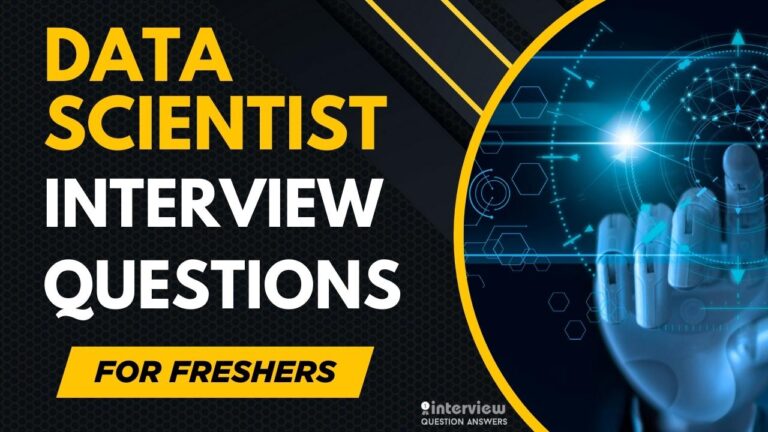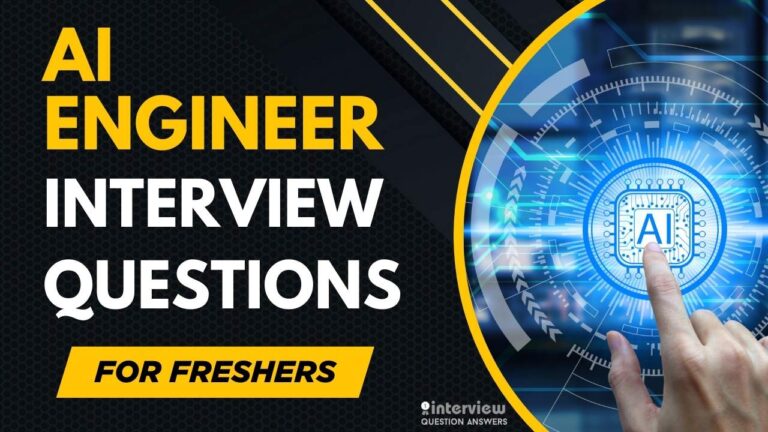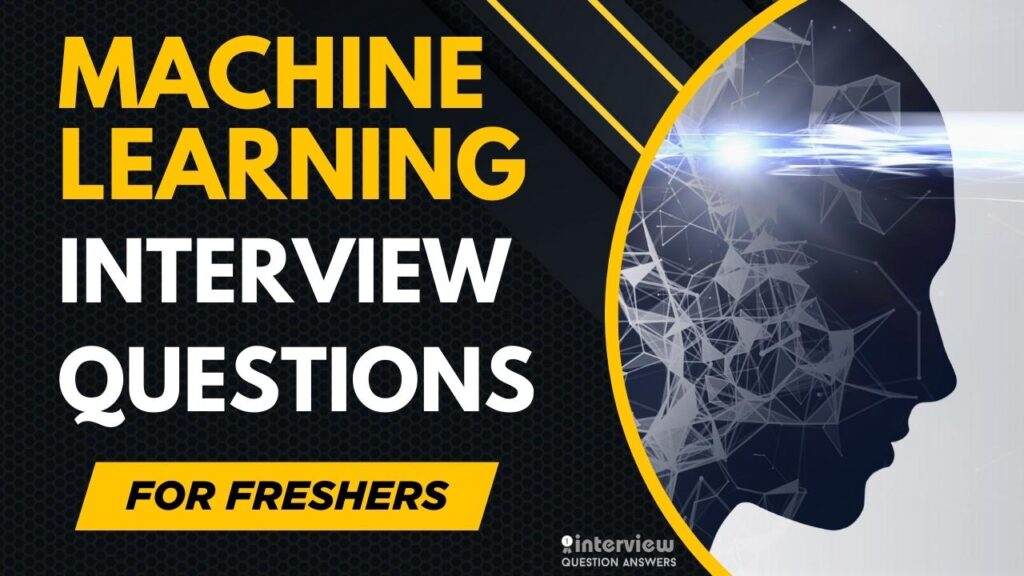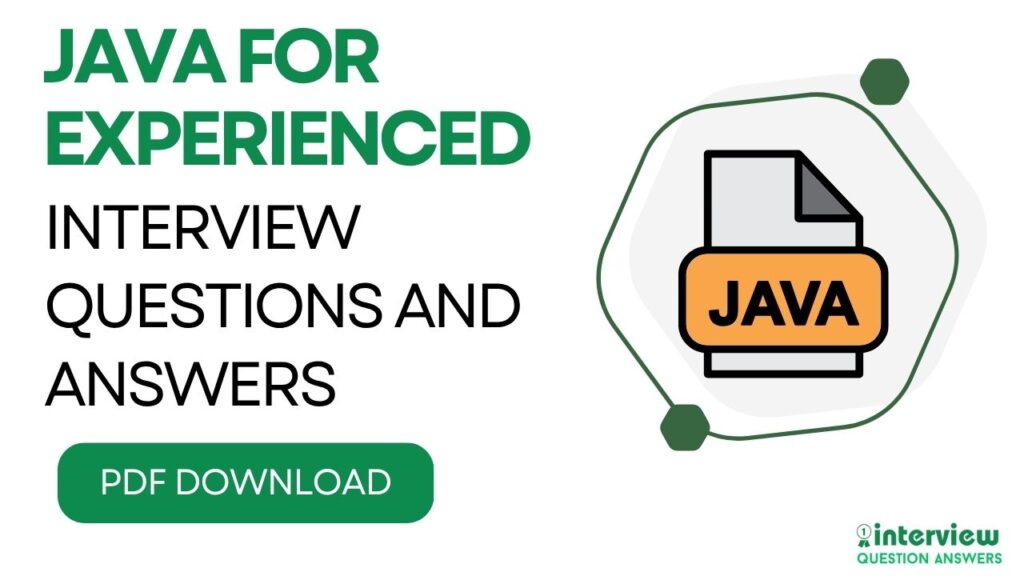Most Common Data Engineer Interview Questions for Freshers 2025
Starting a data engineering career requires mastering both technical fundamentals and system design concepts that employers prioritize for entry-level positions. Data Engineer Interview Questions for Freshers focus on core technologies including SQL databases, ETL processes, and cloud platforms that new graduates must demonstrate.
This comprehensive guide covers Data Engineer Interview Questions for Freshers seeking their first role in this high-demand field, addressing Python programming, data pipeline design, database management, and scalability concepts. Data Engineer Interview Questions for Freshers will help you showcase your technical abilities, problem-solving skills, and readiness to build robust data infrastructure in today’s data-driven market.
You can check another Data Engineer Interview guide here: Data Engineer Interview Questions PDF
Basic Data Engineer Interview Questions for Freshers
Que 1. What is Data Engineering, and what are its key responsibilities?
Answer: Data Engineering focuses on building and maintaining data pipelines that collect, transform, and store data for analysis. Key responsibilities include designing ETL processes, ensuring data quality, managing databases, and optimizing data flow for scalability. For freshers, understanding the role in enabling data science is essential.
Que 2. What is the difference between ETL and ELT?
Answer:
| Aspect | ETL | ELT |
|---|---|---|
| Process Order | Extract, Transform, Load | Extract, Load, Transform |
| Transformation | Before loading to warehouse | After loading to warehouse |
| Use Case | Structured data, legacy systems | Big data, cloud warehouses |
| Tools | Talend, Informatica | Snowflake, BigQuery |
ETL is traditional for on-premise, while ELT leverages cloud computing power.
Que 3. What is Apache Spark, and why is it used in data engineering?
Answer: Apache Spark is an open-source distributed processing framework for big data workloads, using in-memory caching for fast queries. It’s used for ETL, streaming, and machine learning due to its speed (up to 100x faster than Hadoop MapReduce) and scalability.
Example:
from pyspark.sql import SparkSession
spark = SparkSession.builder.appName("Example").getOrCreate()
df = spark.read.csv("data.csv")Que 4. How does HDFS work in Hadoop?
Answer: HDFS (Hadoop Distributed File System) stores large datasets across multiple machines, with data divided into blocks (default 128MB) replicated for fault tolerance. NameNode manages metadata, DataNodes store actual data. For freshers, knowing replication factor (default 3) is important for reliability.
Que 5. What is a NameNode in Hadoop, and what happens if it fails?
Answer: The NameNode is the master node in HDFS, maintaining the directory tree and block locations. If it fails, the cluster becomes unavailable. High-availability setups use a standby NameNode for failover. For freshers, understanding federation for scalability is a plus.
Que 6. Explain MapReduce and its phases.
Answer: MapReduce is a programming model for processing large datasets: Map phase sorts and filters data into key-value pairs, Reduce phase aggregates results. It’s used for batch processing in Hadoop. Phases: Input, Map, Shuffle, Reduce, Output.
Que 7. What is the difference between structured and unstructured data?
Answer:
| Data Type | Description | Examples |
|---|---|---|
| Structured | Organized in rows/columns, schema-based | SQL databases, CSV files |
| Unstructured | No predefined format | Text, images, videos |
Structured data is easy to query; unstructured requires processing like NLP.
Que 8. How do you design a basic data pipeline?
Answer: A data pipeline involves extracting data from sources (e.g., APIs, databases), transforming it (cleaning, aggregating), and loading it to a warehouse. Use tools like Apache Airflow for orchestration. For freshers, focusing on ETL flow is crucial.
Que 9. What is SQL, and why is it important for data engineers?
Answer: SQL (Structured Query Language) manages and queries relational databases. It’s important for data engineers to extract, transform, and load data efficiently, using commands like SELECT, JOIN, and GROUP BY.
Example:
SELECT department, AVG(salary) FROM employees GROUP BY department;Que 10. What is a data warehouse, and how does it differ from a database?
Answer: A data warehouse stores historical data for reporting and analysis, optimized for read-heavy operations. A database handles transactional data (OLTP), while warehouses support OLAP.
Que 11. Explain the concept of big data and the 3Vs.
Answer: Big data refers to large, complex datasets that traditional tools can’t handle. The 3Vs are Volume (size), Velocity (speed of generation), and Variety (structured/unstructured).
Que 12. What is Apache Kafka, and how is it used in data engineering?
Answer: Apache Kafka is a distributed streaming platform for real-time data pipelines. It’s used to ingest, process, and distribute data streams reliably, with topics and partitions for scalability.
Que 13. How do you handle data quality issues in a pipeline?
Answer: Handle data quality by validating schemas, checking for duplicates/missing values, and using tools like Great Expectations or Deequ. Implement alerts for anomalies and automated cleaning scripts.
Que 14. What is AWS S3, and how is it used in data storage?
Answer: AWS S3 (Simple Storage Service) is object storage for scalable data lakes. Data engineers use it for storing raw data, backups, or logs, with features like versioning and encryption.
Que 15. Explain the STAR schema in data warehousing.
Answer: STAR schema is a database schema with a central fact table connected to dimension tables. Fact tables store metrics (e.g., sales), dimensions store attributes (e.g., time, product). It’s simple for querying.
Que 16. What is PySpark, and how does it differ from Pandas?
Answer: PySpark is Python API for Apache Spark, handling distributed data processing. Pandas is for in-memory dataframes; PySpark scales to big data but is slower for small datasets.
Example:
from pyspark.sql import SparkSession
spark = SparkSession.builder.getOrCreate()
df = spark.read.csv("large_data.csv")Que 17. What is a data lake, and how does it differ from a data warehouse?
Answer: A data lake stores raw, unstructured data for flexible analysis, while a data warehouse stores structured, processed data for reporting. Data lakes are cheaper but require governance.
Que 18. How do you use Docker in data engineering?
Answer: Docker containers package applications and dependencies for consistency across environments. Data engineers use it for reproducible ETL jobs or deploying pipelines.
Que 19. What is Airflow, and how is it used for workflow orchestration?
Answer: Apache Airflow schedules and monitors workflows as DAGs (Directed Acyclic Graphs). It’s used to define ETL pipelines in Python code, with tasks for dependencies.
Que 20. Explain ACID properties in databases.
Answer: ACID ensures reliable transactions:
- Atomicity: All or nothing.
- Consistency: Valid state after transaction.
- Isolation: Concurrent transactions don’t interfere.
- Durability: Changes persist after commit.
Que 21. What is the role of a Data Engineer in a data team?
Answer: Data Engineers build and maintain data infrastructure, pipelines, and storage for data scientists/analysts to access clean data. They focus on scalability and reliability.
Que 22. How do you handle large-scale data ingestion?
Answer: Use streaming tools like Kafka for real-time ingestion or batch tools like Apache NiFi. For freshers, partitioning data and using cloud services like AWS Kinesis is common.
Que 23. What is Snowflake, and how does it differ from traditional databases?
Answer: Snowflake is a cloud data warehouse separating storage and compute for scalability. It differs from traditional databases by offering pay-per-use and automatic scaling.
Que 24. How do you implement data partitioning in Hive or Spark?
Answer: Partitioning divides data by keys (e.g., date) for faster queries. In Spark:
Example:
df.write.partitionBy("date").parquet("output_path")Que 25. What is the difference between batch and stream processing?
Answer: Batch processing handles data in fixed intervals (e.g., Hadoop MapReduce), while stream processing handles real-time data (e.g., Spark Streaming). Batch is for historical analysis; stream for live monitoring.# 25 Basic Data Engineer Interview Questions and Answers for Freshers
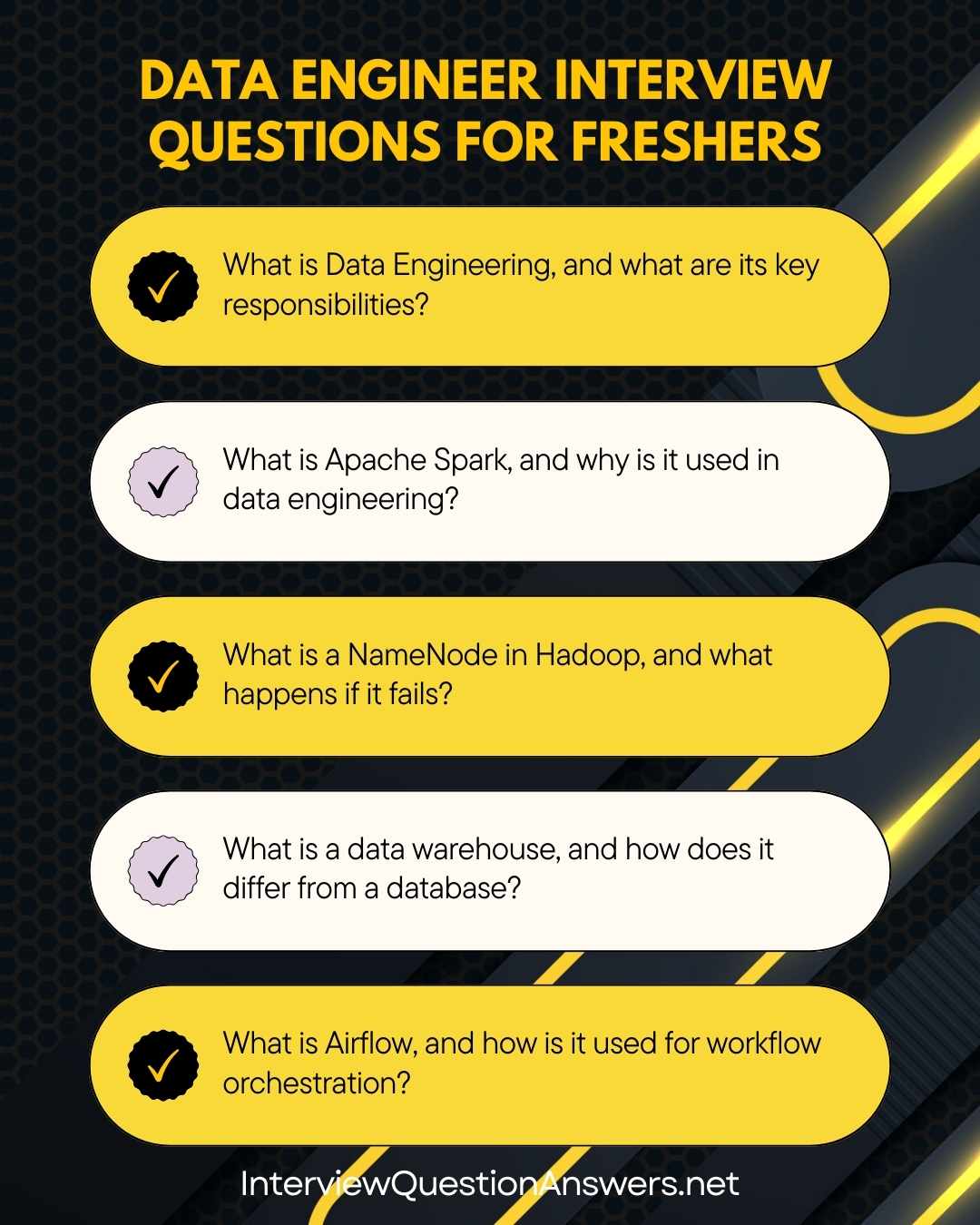
Guide for Experienced: Data Engineer Interview Questions for Experienced
Advanced Data Engineer Interview Questions for Freshers
Que 26. What is the difference between a data warehouse and a data lake, and how do they complement each other in a modern data architecture?
Answer: A data warehouse is a structured repository optimized for querying and reporting, storing processed and schema-enforced data for business intelligence, while a data lake is a flexible storage system that holds raw, unstructured, and semi-structured data in its native format for future use. In a modern data architecture, data lakes serve as the initial landing zone for massive volumes of diverse data from various sources, allowing data engineers to ingest everything without upfront transformation.
Data warehouses, on the other hand, pull curated subsets from the lake after ETL/ELT processes, enabling efficient analytics. This lakehouse approach combines the scalability of lakes with the reliability of warehouses, using tools like Delta Lake for ACID transactions on lakes. For freshers in 2025, understanding this complementarity is crucial as hybrid architectures become standard in cloud environments like AWS or Azure, where lakes handle big data ingestion and warehouses support BI tools like Tableau.
Que 27. How does Apache Airflow work for orchestrating data pipelines, and what are its key components?
Answer: Apache Airflow is an open-source platform for programmatically authoring, scheduling, and monitoring workflows as Directed Acyclic Graphs (DAGs), where each node represents a task and edges define dependencies. It uses Python to define pipelines, with the scheduler executing tasks based on time or events, and the web UI providing visualization and logs. Key components include the Scheduler (manages task execution), Executor (runs tasks, e.g., Celery for distributed), Metadata Database (stores DAG states), and Operators (pre-built tasks like BashOperator or PythonOperator). Airflow’s extensibility allows custom operators for integration with tools like Spark or Kafka. For freshers, mastering DAG design ensures robust, fault-tolerant pipelines, with features like retries and SLAs handling failures gracefully in production environments.
Example:
from airflow import DAG
from airflow.operators.bash import BashOperator
from datetime import datetime
dag = DAG('example_dag', start_date=datetime(2025, 1, 1))
task = BashOperator(task_id='run_script', bash_command='python script.py', dag=dag)
Que 28. What is data partitioning, and how does it improve performance in big data systems like Spark or Hive?
Answer: Data partitioning divides datasets into smaller, manageable segments based on a key (e.g., date or region), storing them in separate directories or tables to enable faster queries by scanning only relevant partitions. In Spark or Hive, this reduces I/O operations and speeds up processing, as queries use partition pruning to skip irrelevant data. For example, partitioning by year in a sales table allows queries for 2025 data to ignore other years. Implementation involves specifying partition columns during table creation or write operations. For freshers in 2025, understanding dynamic vs. static partitioning and avoiding over-partitioning (which can lead to small file problems) is essential for optimizing storage and query performance in distributed systems, where tools like Hive’s ALTER TABLE ADD PARTITION manage partitions efficiently.
Que 29. How do you design an ETL pipeline for real-time data processing using Apache Kafka and Spark Streaming?
Answer: Designing an ETL pipeline for real-time data involves using Apache Kafka as a messaging system to ingest streaming data from sources like IoT devices or logs, where topics partition data for scalability. Spark Streaming processes this data in micro-batches, transforming it (e.g., filtering, aggregating) before loading to a sink like HDFS or Cassandra. Key steps include setting up Kafka producers for data ingestion, configuring Spark to consume from Kafka topics using Direct Stream API, applying transformations in Spark (e.g., using DataFrames for SQL-like operations), and ensuring fault tolerance with checkpointing. For freshers in 2025, handling windowed computations for time-based aggregations and integrating with schema registries like Confluent for evolving data schemas are critical to building resilient, scalable pipelines that support near-real-time analytics.
Example:
val streamingContext = new StreamingContext(sparkConf, Seconds(1))
val topics = Array("input_topic")
val stream = KafkaUtils.createDirectStream[String, String](streamingContext, PreferConsistent, Subscribe[String, String](topics, kafkaParams))
stream.map(record => (record.key, record.value)).print()
Que 30. What are the challenges of handling data skew in distributed systems like Spark, and how do you mitigate them?
Answer: Data skew occurs when data is unevenly distributed across partitions, causing some tasks to take longer due to overload, leading to performance bottlenecks in distributed systems like Spark. Challenges include prolonged job completion times, resource inefficiency, and potential out-of-memory errors on overloaded nodes. Mitigation strategies involve repartitioning data using custom partitioners (e.g., based on hash or range), salting keys to balance distribution (adding random suffixes to skewed keys), or using broadcast joins for small datasets. For freshers in 2025, monitoring skew with Spark’s UI (task duration variances) and applying techniques like AQE (Adaptive Query Execution) in Spark 3.0, which dynamically coalesces partitions, are vital for maintaining efficient processing in large-scale ETL jobs.
Que 31. Explain the architecture of Apache Hadoop and its core components.
Answer: Apache Hadoop is a framework for distributed storage and processing of big data, consisting of HDFS for storage and YARN for resource management. Core components include HDFS (with NameNode for metadata and DataNodes for storage), YARN (ResourceManager for cluster resources, NodeManagers for node-level execution), and MapReduce for processing (though often replaced by Spark). The architecture supports fault tolerance through data replication (default factor 3) and scalability by adding nodes. For freshers in 2025, understanding how Hadoop integrates with ecosystems like Hive (for SQL querying) or HBase (for NoSQL storage) is crucial for building reliable, horizontally scalable data platforms.
Que 32. How do you implement incremental data loading in ETL pipelines to handle large datasets efficiently?
Answer: Incremental loading updates only new or changed data since the last load, reducing processing time and resource usage. Implement by tracking watermarks (e.g., timestamps or IDs) in a metadata table, querying source data with conditions (e.g., WHERE modified_date > last_load_date), and merging into the target using UPSERT operations in tools like Delta Lake or SQL MERGE. For freshers in 2025, using Apache Airflow to schedule jobs and handle dependencies, along with change data capture (CDC) tools like Debezium for real-time increments, ensures efficiency in handling petabyte-scale data without full reloads, minimizing downtime and costs.
Que 33. What is schema evolution, and how do you manage it in data lakes using formats like Parquet or Avro?
Answer: Schema evolution allows changes to data schemas (e.g., adding columns) without breaking existing data or queries. Parquet supports evolution by storing metadata in files, allowing backward compatibility, while Avro embeds schemas in files for forward/backward compatibility. Manage by using schema registries (e.g., Confluent Schema Registry) to validate changes and tools like Apache Spark to handle schema merging during reads. For freshers in 2025, ensuring compatibility modes (e.g., backward for consumers) and testing migrations prevent data corruption in evolving pipelines.
Que 34. How do you optimize Spark jobs for performance in a production environment?
Answer: Optimize Spark jobs by tuning parameters like executor memory/cores (--executor-memory, --num-executors), using broadcast joins for small datasets, caching frequently used DataFrames (persist() with MEMORY_AND_DISK), and repartitioning to avoid skew (repartition()). Monitor with Spark UI for spills or slow tasks, and enable dynamic allocation for resource efficiency. For freshers in 2025, leveraging AQE (Adaptive Query Execution) in Spark 3+ automatically optimizes joins and partitions, while profiling with tools like Ganglia ensures jobs run efficiently on clusters.
Que 35. What are the key differences between batch and stream processing, and how do you choose between them?
Answer: Batch processing handles data in fixed intervals (e.g., nightly jobs with Spark), suitable for historical analysis, while stream processing (e.g., Spark Streaming or Flink) handles real-time data for immediate insights.
| Aspect | Batch | Stream |
|---|---|---|
| Latency | High (minutes-hours) | Low (milliseconds) |
| Use Case | Reporting, ETL | Monitoring, fraud detection |
| Tools | Hadoop MapReduce, Spark Batch | Kafka, Flink |
Choose batch for cost-effective large-scale processing; stream for time-sensitive applications. For freshers, hybrid approaches like Lambda Architecture combine both for comprehensive systems.
Que 36. How do you ensure data security and privacy in data pipelines?
Answer: Ensure security by encrypting data at rest (e.g., AES in S3) and in transit (TLS), using access controls (IAM roles in AWS), and anonymizing sensitive data with masking or tokenization. Comply with regulations like GDPR by implementing data lineage tracking in tools like Apache Atlas. For freshers in 2025, auditing logs with ELK Stack and using secure protocols like Kerberos in Hadoop clusters prevent breaches in production pipelines.
Que 37. What is Apache NiFi, and how is it used for data ingestion?
Answer: Apache NiFi is a data flow tool for automating data movement between systems, using a web UI to design flows with processors for routing, transforming, and enriching data. It’s used for ingestion from sources like APIs or logs to sinks like HDFS. For freshers, its fault-tolerant design with data provenance tracking ensures reliable, auditable pipelines.
Que 38. How do you handle schema drift in streaming data pipelines?
Answer: Schema drift occurs when data schemas change unexpectedly. Handle by using schema registries (e.g., Confluent for Kafka) to validate and evolve schemas, implementing backward/forward compatibility, and alerting on drift with monitoring tools like Prometheus. For freshers in 2025, using Avro or Protobuf formats in Spark Streaming allows safe evolution without breaking consumers.
Que 39. What are the advantages of using columnar storage formats like Parquet in data engineering?
Answer: Parquet is a columnar format that compresses data efficiently, supports schema evolution, and enables fast queries by reading only needed columns. Advantages include reduced storage costs (up to 75% compression) and improved performance in analytical workloads (e.g., Spark SQL). For freshers, integrating Parquet with data lakes in S3 optimizes big data processing.
Que 40. How do you implement fault-tolerant data pipelines using Apache Airflow?
Answer: Implement fault tolerance in Airflow by setting retries on tasks (retries=3, retry_delay=timedelta(minutes=5)), using SLAs for alerts, and designing DAGs with branching for error handling. Use executors like Celery for distributed execution. For freshers in 2025, integrating with monitoring tools like Sentry and using hooks for database connections ensure pipelines recover from failures gracefully.
Que 41. What is the role of a metadata management system in data engineering?
Answer: Metadata management systems (e.g., Apache Atlas or Amundsen) catalog data assets, track lineage, and ensure governance. They help in discovering data, understanding origins, and complying with regulations. For freshers, integrating with catalogs like Hive Metastore enables self-service analytics.
Que 42. What are the best practices for handling streaming data with exactly-once semantics?
Answer: Use idempotent operations, transactional sinks in Flink or Kafka Streams, and checkpoints for state recovery. For freshers, leveraging Kafka’s transactional APIs ensures data is processed exactly once despite failures.
Que 43. How do you use data versioning tools like DVC in data engineering workflows?
Answer: DVC tracks data versions like Git for code, storing metadata in Git and large files in remote storage (e.g., S3). For freshers in 2025, integrating DVC with pipelines reproduces experiments and manages model inputs.
Que 44. What is the role of a schema registry in streaming data systems?
Answer: A schema registry (e.g., Confluent) manages schema versions for producers/consumers, ensuring compatibility and evolution without breaking pipelines. For freshers, it supports formats like Avro for evolving data.
Que 45. How do you optimize Spark SQL queries for large-scale data warehouses?
Answer: Use broadcast joins for small tables, cache frequent datasets, and partition by query patterns. For freshers in 2025, enabling AQE and analyzing with EXPLAIN plans in Spark UI identifies and resolves performance issues.
Que 46. What are the challenges of implementing a data mesh architecture, and how do you overcome them?
Answer: Challenges include data governance, interoperability, and skill gaps across domains. Overcome by establishing federated governance, using domain-driven design, and providing self-service tools like dbt. For freshers, starting with pilot domains ensures gradual adoption.
Que 47. How do you handle data privacy in global data pipelines?
Answer: Comply with regulations like GDPR/CCPA by anonymizing data (e.g., differential privacy), using encryption, and implementing data residency controls. For freshers in 2025, tools like Privacera for policy enforcement ensure privacy across borders.
Que 48. What is the difference between Apache Beam and Google Dataflow?
Answer: Apache Beam is a unified programming model for batch/stream processing, portable across runners. Google Dataflow is a managed service runner for Beam, providing serverless execution. For freshers, Beam’s portability allows switching between Dataflow and Spark.
Que 49. How do you implement a real-time recommendation engine data pipeline?
Answer: Use Kafka for ingestion, Flink for processing user events, and Cassandra for storing recommendations. For freshers in 2025, integrating ML models with TensorFlow Serving and monitoring latency ensures responsive systems.
Que 50. What are the best practices for data backup and disaster recovery in data engineering?
Answer: Implement incremental backups with tools like AWS Backup, use geo-redundancy for storage (e.g., S3 Cross-Region Replication), and test recovery plans regularly. For freshers, automating with Airflow and monitoring RTO/RPO metrics ensures business continuity.
Conclusion
We have already shared the essential questions for Data Engineer Interview Questions for Freshers. This comprehensive Data Engineer Guide includes interview questions for fresh graduates, covering both basic and advanced concepts that employers commonly evaluate. The data engineering industry is rapidly evolving with containerization, stream processing, and cloud-native architectures becoming standard requirements for entry-level positions.
These Data Engineer Interview Questions for Freshers provide the technical foundation needed to succeed in your job search, covering ETL pipelines to distributed computing frameworks. With proper preparation using these Data Engineer Interview Questions for Freshers and understanding current industry demands, you’ll be well-positioned to launch your data engineering career.
You can also check:




